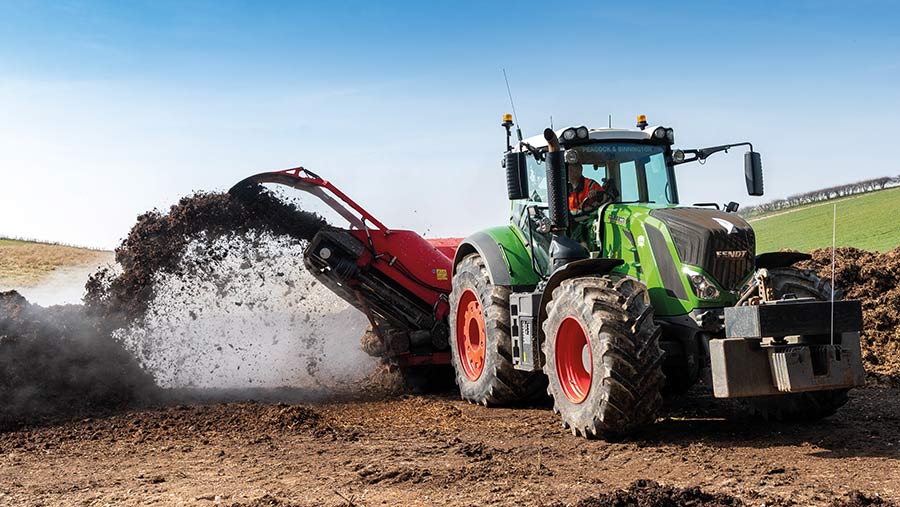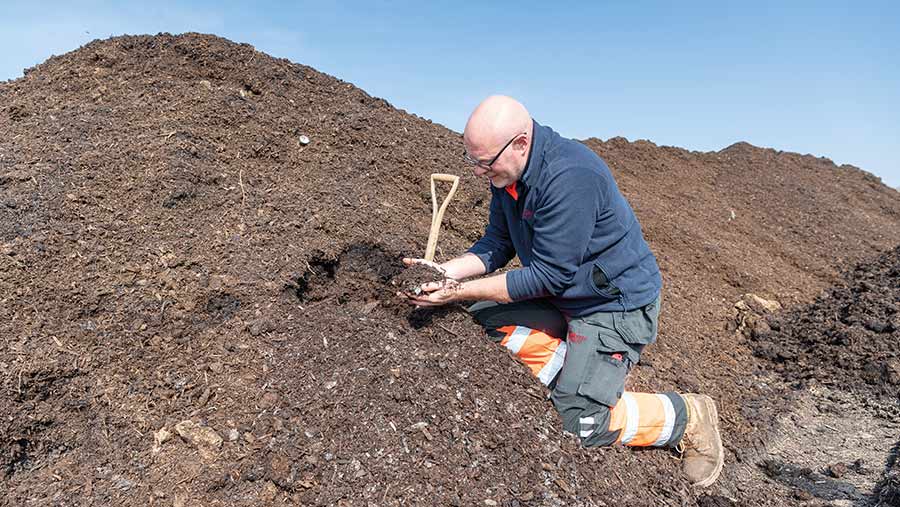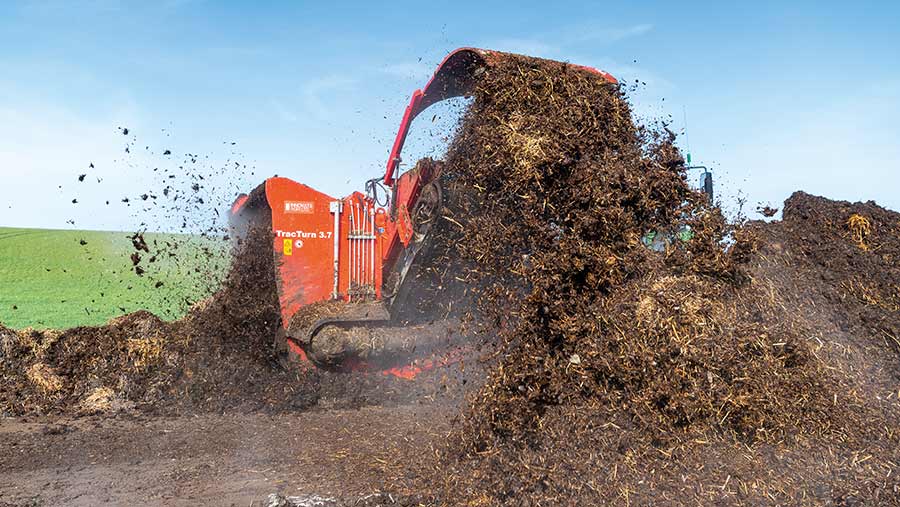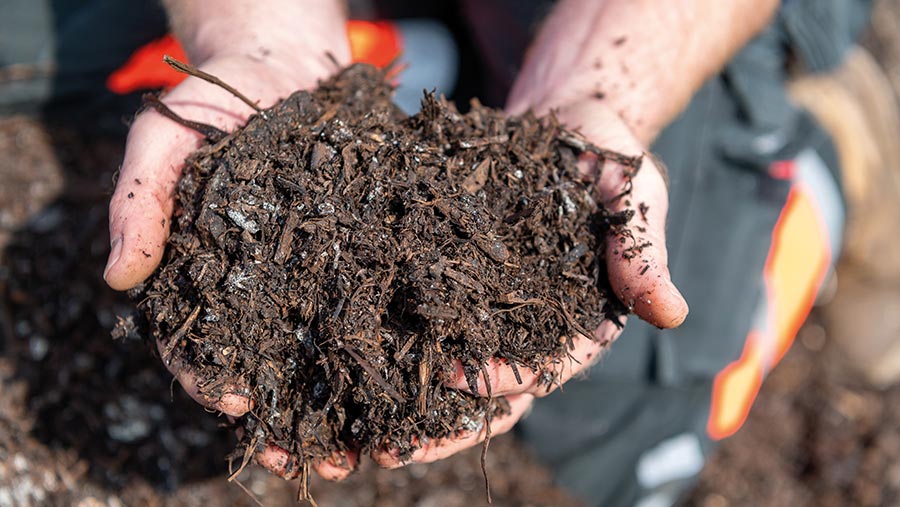Why composting could help with new autumn manure rules
 © Wayne Hutchinson
© Wayne Hutchinson Yorkshire contractor Richard Scholes knew his contracting business had to adapt when the Farming Rules For Water legislation prohibited a number of autumn manure applications*.
Faced with soaring fertiliser costs, a greater emphasis on environmental schemes and a push for soil health improvements, he came across the idea of composting.
After some investigation, he discovered not only did a composted manure offer a more consistent product with improved nutrient value and reduced leaching risk, but it was permitted for autumn spreading.
See also: How to control yellow rust in wheat without epoxiconazole
“With legal compliance changing and many farmers looking to scale back on artificial fertiliser, the introduction of the composting service to our business – Innovate Agri – made perfect sense,” says Mr Scholes.
This is because a properly composted manure has a very small amount of readily available nitrogen and, therefore, is unlikely to pose a nitrate-nitrogen risk when applied in the autumn.
(See NFU latest on Farming Rules for Water.)
Prohibitions
Farmyard manures are a valuable commodity, offering a home-produced nutrient source.
Too often manures are viewed as a waste material, but this mindset is changing – now more than ever given the fertiliser price hike.
However, unless there is a specific crop requirement and a maximum of 5kg/ha nitrate-nitrogen leaching risk, the Farming Rules for Water prohibits applications of autumn manure.
With a sense of confusion and frustration looming over industry legislation, the government’s push to move to spring applications is deemed impractical.
What’s more, spring manure applications can lead to a significant loss of nitrogen into the atmosphere via a process known as volatilisation, which can be as high as 50%.
“Muck is not like opening a bag of diammonium phosphate or ammonium nitrate. Its nutritious value is difficult to quantify and, therefore, is completely different in how it should be applied,” Mr Scholes says.

© Wayne Hutchinson
Potential solution
However, the legislation is not a complete spreading ban and applying a composted manure offers a potential solution to overcome this issue.
A correctly composted manure can be applied in the autumn within the rules, as readily available “leachable” nitrogen found in manures is converted into an organic, more stable form of N which binds to soil particles.
“By applying compost, you are essentially banking the nitrogen content within the soil, which allows for a more gradual release of nitrogen as it naturally mineralises over time, which reduces leaching risks.
“If we think of it on a scale of leachable materials, slurry, digestate and poultry manures are very high-risk sources and are, therefore, very limited for autumn spreading.”
Compost, however, is at the complete other end of the spectrum. “As long as you apply it within crop requirements as stated, it can be applied in autumn,” he tells Farmers Weekly.

Richard Scholes © Wayne Hutchinson
The composting process
Included in Mr Scholes’ 10- to 12-week composting service is the initial setup of the windrow pile, mixing with the specialist compost turner and subsequent monitoring of the pile.
The speed and effectiveness of compost depends on many variables, including the nature of the farmyard manure, the turning regime, the addition of other ingredients and achieving the right carbon-nitrogen ratio.
In order to create the optimum compost, Mr Scholes ensures three key requirements are met:
- Correct moisture content Too dry and microbes will not function. Too wet and the compost will not be sufficiently aerated and microbes will be unable to break down carbon
- Optimum bulk density Fresh manure should be aerobic, with air able to flow through the compost pile. “A good indicator is that a composting windrow should be steaming on a cool morning as it expels heat from the top while drawing in fresh air through the sides,” he says
- Correct carbon:nitrogen ratio Depending on the type and content of manure, some fine-tuning of ingredients maybe be required.
“Cattle manure usually ticks all the boxes right away, so no other additions are required. We can reintroduce an old batch of compost preloaded with the right bacteria to kick-start the process, if required.”
Broiler muck, on the other hand, is particularly high in nitrogen, so a carbon source such as straw or woodchip can be added to balance out the ratio.
“The addition of water or layer muck, which has a wetter consistency, can help achieve the optimum moisture content, as broiler muck is known to be quite dry.”

© Wayne Hutchinson
Weed elimination
Once the ingredients are fine-tuned, the windrow pile is established. The size and shape of the heap is key to making a successful compost, aiming for a trapezium-shaped pile to maximise surface area.
The turner then runs through the material to create a loose, fluffy structure with good porosity. Within 24 hours, temperatures within the heap should reach 55-70C.
These temperatures are effective at destroying weed seeds, particularly blackgrass, which requires a three-day exposure of temperatures 55C and above to prevent the seed from germinating.
Turning the compost ensures any potential weeds are exposed to the threshold.
“This is particularly important as there is no risk of weed contamination from farm to farm and opens up the potential for straw-for-compost deals without weed infection risks,” Mr Scholes says.
Bacteria-building
Turning is a rapid process, using the Compost Systems Trac Turn, which is capable of turning 2,000cu m/hour.
In the initial thermophillic phase, bacteria populations increase as temperatures rise.
These thermophillic micro-organisms use nitrogen as a protein source to decompose carbon, which is ultimately driven by the level of oxygen present.
Ensuring good airflow through the compost is therefore essential, as the bacteria require oxygen to respire.
In general, the compost heap is turned four to six times, with increasing length of time between each turn, spending seven to eight weeks in this phase.
As the process continues, the compost pile gets smaller as carbon is broken down, meaning temperatures fall.
Once temperatures reach 40C or less, the mesophillic phase begins to take hold, where the compost heap no longer needs intervention. All it requires is a three- to four-week resting period before it can be applied.
“This is why we monitor temperature closely, as it acts as a good indicator of bacterial activity.
“Once the temperature doesn’t respond to turning, we know the thermophillic phase has ended and greater fungal development can be expected when the pile is no longer turned.”
*This article was published before Defra released new guidance on the Farming Rules for Water.
Case study: Andrew Megginson, Kirkburn Grange Farm, East Yorkshire
East Yorkshire poultry and arable farmer Andrew Megginson turned to composting to overcome the Farming Rules for Water legislation.
This will enable him to continue autumn applications and offer a more wholesome farming approach.
Poultry manure plays a key role within the 600ha of arable cropping at Kirkburn Grange Farm, reducing reliance on artificial fertiliser and eliminating requirements of bought-in phosphorus and potassium.
However, Mr Megginson was left feeling frustrated and confused over how he would manage 1,700t of poultry manure stocks at the farm near Driffield, home to five batches of broiler chickens in groups of up to 220,000.
About half of the farm’s poultry manure is applied in the spring ahead of potatoes and is, therefore, unaffected by the rule, but a significant proportion was previously used ahead of second wheats in the autumn.
“Boiler muck was an excellent soil conditioner and benefited second wheats exceptionally well. It built up organic matter levels across the farm considerably, with levels now reaching index 5,” he says.
Muck was also particularly good at managing take-all levels, he continues, with no requirement for a latitude seed dressing.
When his father kickstarted the poultry business 60 years ago, there was capacity for 8,000 broilers on farm.
As a result of economies of scale and considerable growth of the business, capacity has increased by a huge 2,650%, which means considerably more muck to manage as well.
Mr Megginson therefore needed to find a way to manage the remaining poultry manure that was not destined for potato ground and maintain its use within the arable rotation to benefit crop and soil health.
Last spring, he decided to set up a simple field trial plot to investigate the effectiveness of spring applications in a standing winter wheat crop.
He made an application of broiler muck in late March at a rate of 5t/ha and tested a wheat leaf sample with a hand-held N-sensor to monitor uptake.
However, he found no nitrogen difference between the treated and untreated crops. He suspects a considerable percentage of the nitrogen applied was volatilised into the atmosphere and, therefore, no longer available to the crop.
Compost solution
With spring applications impractical and concerns over volatilisation, he came across the idea of composting from Richard Scholes of Innovate Agri.
Mr Scholes had previously undertaken muckspreading work on the farm and after offering his composing services, Mr Megginson now feels compost holds the real answer to the muck issue.
“I am really excited about the whole composting process and the many benefits it will bring to our farm. It has real potential to future-proof our business. It feels as if we are doing the right thing, at the right time.”
After completing the first batch of compost from 150t of manure, he now aims to compost a total of 800-900t.
Straw is added to optimise the carbon-nitrogen ratio, as broiler manure has a naturally high nitrogen content, alongside a splash of water to ensure the pile aerates efficiently.
Growing winter wheat, winter barley, oilseed rape, potatoes and vining peas using a plough-based system, composting will allow for the continued use of organic material back into soils.
He hopes it will increase efficiency of poultry manure, particularly given the current high fertiliser price, and keep soils in good health.
So far this season, fertiliser rates for milling wheats will mostly stay the same, as the majority of fertiliser was bought before the price rise.
The milling wheat varieties Crusoe, Skyfall, Zyatt and Extase grown on farm will receive 220-300kg N/ha, to include applications of broiler muck.
Average yields across both first and second wheats is pushing 11t/ha, with grain supplied to Bradshaw’s, just a few miles away.
Mr Megginson also uses cover crops ahead of potatoes and grazes them off with sheep.
Benefits of composting manure

© Wayne Hutchinson
A composted manure offers many benefits, including a more consistent soil amendment with a more accurate nutritious value for ease of application.
- Cuts volume weight
- Lower spreading costs
- More stable form of nitrogen, carbon and other nutrients
- Helps build organic matter
- Good soil conditioner with improved nutrient cycling
- Improved spreading accuracy
- Reduces risk of nutrient loss and pollution during storage
- Cuts nitrate leaching risk when applied to land
- Eliminates weed burden
- Reduces odour problems
- Improved beneficial microbial activity
- Legal compliance with no autumn spreading restriction
Typically, the volume and moisture content of a farmyard manure halves from start to finish of the composting process, leading to significantly lower haulage and spreading costs.
For example, Mr Scholes states that: “When applying pig muck this consists of 25% of dry matter, which means 75% is water, which is very expensive to transport and spread. By composting we are achieving a more concentrated and consistent product in a smaller volume.”
When you account for these benefits, it goes a long way to offset the cost of composting, which Mr Scholes calculates comes to £2.50-£3.50/t of compost.
“In fact, when you take into account the nitrogen retained, and the spreading and haulage costs saved, you’re actually making a huge saving, benefiting soils and staying legal.”

